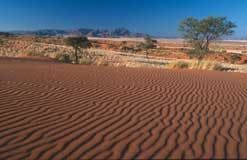Solar and wind powers pumps in Namibian desert
By Carsten Kvistgaard
The sun beats down from a deep blue, cloudless sky, and the thermometer reaches well above 30ºC although it's July and mid-winter. Red sand, dry grass and rugged mountains stretch out towards the horizon in all directions and the nearest water and power supplies are hundreds of kilometres away.
Yet life is in abundance. Sun and wind power pumps that provide the essential water holes for the wildlife in the Namibrand Reserve.
Sun and wind energy provide enough power to operate four Grundfos SQFlex plants installed in boreholes at a game reserve, located in one of the world's most desolate and dry areas — the desert of Namibia.
The Namibian desert is no-man's land from the shore of the Atlantic Ocean to the barren mountains 150 km inland. Rain falls once or twice a year, just enough to maintain the sparse vegetation. Farmers have tried sheep farming but since 1988 an area of almost 2,000 km2 has been converted into a private nature reserve in which the original fauna and flora have been re-established. The stock of game has since increased slowly but steadily and today more than 4,000 stocks of game live in the area. Most are antelope species like oryx and springbok, but also wilder beasts, zebras, bat-eared foxes, jackals and a few leopards have settled in together with approximately 100 bird species.
Access to waterholes is vital although the animals are robust and able to survive for a long time without water. The rain can be fierce, when it finally comes, but the water quickly seeps into the dry ground and disappears into the underground and the rest evaporates in the heat. The ground does contain water 50 to 100 metres below.
Achim Lenssen, the chief ranger in Namibrand, has tried almost everything to get the water to the surface for the animals. Inefficient piston pumps driven by diesel engines and old windmills have pumped scarce volumes of water to the surface, but it has been expensive and laborious. "It takes most of the day to drive out to a pump to repair it or just fill it with diesel oil, and we had to do that several times a week," said Lenssen.
One Grundfos plant operates on both solar and wind energy. It pumps water from a depth of 60 metres and into a basin situated two kilometres away and 40 metres higher. In this basin, a fifth SQFlex pump recently replaced an old diesel pump to lift water to an even higher level from which an underground piping system leads it by gravity to waterholes situated at a lower level and spread out in an area of 10,000 hectares. Three other systems cover similar areas.
Installed by the Namibian Engineering Corporation (NEC) of Windhoek, Namibia, the SQFlex pumps have proven their reliability, according to Lenssen. He explained: "In the beginning we kept a very close eye on them, but we do not do that anymore because they take care of themselves. Now we can concentrate on actual game and nature tending and we save a lot of money."
Sabotage is the only problem that Lenssen reports. Hyenas bit into everything. Hyenas bit holes in the wiring at night when the power was turned off. The ranger placed the cables inside of iron pipes and reinforced the fence around the solar panels, so now the plants are left alone.
Game researchers also use water from SQFlex to create an artificial waterhole that, together with the dead animals, attract the endangered vultures in the area. Researchers observe the behaviour of vultures from an underground hiding place.
Author's NoteCarsten Kvistgaard, a photo journalist for the Danish company Grundfos, visited Namibrand in July 2003. For more information, contact the author at Email: [email protected]. Visit the website www.namibrand.com for more information about the Namibrand Nature Reserve.


